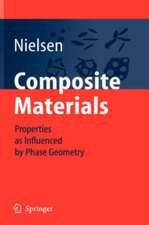Phase-Separation Phenomena in Glasses / Likvatsionnye Yavleniya v Steklakh / Ликвационные Явления в Стеклах: Proceedings of the first All-Union Symposium on Phase-Separation Phenomena in Glasses, Leningrad, April 16–18, 1968: The Structure of Glass
Editat de E. A. Porai-Koshitsen Limba Engleză Paperback – 8 oct 2012
Preț: 947.50 lei
Preț vechi: 1155.48 lei
-18% Nou
Puncte Express: 1421
Preț estimativ în valută:
181.30€ • 188.92$ • 150.12£
181.30€ • 188.92$ • 150.12£
Carte tipărită la comandă
Livrare economică 03-17 aprilie
Preluare comenzi: 021 569.72.76
Specificații
ISBN-13: 9781475701593
ISBN-10: 1475701594
Pagini: 220
Ilustrații: IX, 208 p. 242 illus.
Dimensiuni: 210 x 279 x 12 mm
Greutate: 0.5 kg
Ediția:1973
Editura: Springer Us
Colecția Springer
Seria The Structure of Glass
Locul publicării:New York, NY, United States
ISBN-10: 1475701594
Pagini: 220
Ilustrații: IX, 208 p. 242 illus.
Dimensiuni: 210 x 279 x 12 mm
Greutate: 0.5 kg
Ediția:1973
Editura: Springer Us
Colecția Springer
Seria The Structure of Glass
Locul publicării:New York, NY, United States
Public țintă
ResearchCuprins
Opening of the Symposium.- Introductory Address.- I. General Aspects of Phase Separation in Glasses.- Causes of Phase Separation in Simple Silicate Systems.- Theory of Phase Separation and Atomic-Ionic Structure of Certain Two-Component Systems.- Some Thermodynamic Aspects of Phase-Separation Phenomena.- Primary and Secondary Phase Separation in Glasses.- Investigation of the Physical and Chemical Properties of Glasses Undergoing Phase Separation as a Method of Studying Their Structure.- Influence of Structural Heterogeneity on Physical and Chemical Properties of Glasses.- Determination of the Nucleation Rate of New Phases in Glasses at the Initial Stages of Phase Conversion.- Surface-Active Properties of Catalysts and Phase Separation in Glasses.- II. Phase Separation in Alkali Silicate and Borosilicate Glasses.- Influence of the Oxides of Lithium, Potassium, and Cesium on Phase Separation in Sodium Silicate Glasses.- Relation between the Microheterogeneity of Lithium Silicate Glasses and the Rate of Their Dissolution in Hydrofluoric Acid.- Study of Phase-Separation Processes in the Sodium Silicate Instem by the Electromotive Force Method.- Influence of Heat Treatment on Viscosity of Sodium Silicate and Sodium Borosilicate Glasses.- Regions of Metastable Phase Separation in Ternary Alkali Borosilicate Systems.- Composition of Coexisting Phases in Sodium Borosilicate Glasses Exhibiting Phase Separation.- Influence of Composition on Viscosity and Transformation Temperatures of Borosilicate Glasses Exhibiting Phase Separation.- Porous Glasses as a Source of Information on Structural Changes in Sodium Borosilicate Glasses Undergoing Phase Separation.- Investigation of Phase Separation in Glasses of the Instem R2O-B2O3-SiO2 by Study of Their Electrical Properties.- Influence of Replacement of Silica by Various Glass-Forming Oxides on the Tendency to Phase Separation in the System R2O-B2O3-SiO2.- Phase Separation in Low-Alkali Borosilicate Glasses Containing RO and Al2O3.- Properties of Glasses Exhibiting Phase Separation in the System SiO2-B2O3-Al2O3-ZnO-Na2O.- Influence of Lead Oxide on the Structure and Properties of Borosilicate Glass.- Influence of the Composition and Ratio of the Separated Phases on Stresses Arising During Leaching of Two-Phase Sodium Borosilicate Glasses.- Structural Physical State of Microheterogeneous Glasses.- Use of Differential Thermal Analysis and Dilatometric Measurements for Study of Phase-Separation Phenomena in Glasses.- III. Phase Separation in Other Multicomponent Glasses.- EPR Study of Structural Changes During Microphase Separation in Titanium-Containing Glasses.- Investigation of Phase-Separation Processes in Titanium-Containing Glasses in the System SiO2-Al2O3-CaO-MgO.- Influence of Titanium Dioxide on Phase Separation in Lithium Aluminosilicate Glasses.- Phase-Separation Phenomena in Glasses of Aluminosilicate Systems Containing Various Modifier Cations.- Microphase Separation in Glass Containing Certain Crystallization Initiators.- Influence of Phase Separation on Physical and Chemical Properties of Heat-Treated Fibers.- Photochromism and Microphase Separation of Glass.- Droplet Separation in Photosensitive Glass.- Spectroscopic Investigation of Glasses in the System R2O-La2O3-SiO2.- Use of the Spectral Luminescence Method for Studying Phase Separation in Silicate Glasses.- Influence of Microphase Separation in Fluoberyllate Glasses on the Concentration Dependence of Certain Properties.- Phase-Separation Phenomena in Glasses of the System La2 O3-B2O3-P2O5.- Differentiation of Structural Groups in Slag Glasses.- Phase-Separation Phenomena During Thermal Aging of Multicomponent Thermometer Glasses and Their Influence on Physical Properties.- Influence of Phase Separation on Certain Properties of Glasses in the System SiO2-Al2O3-B2O3-Bi2O3-CeO2-ZrO2.
























